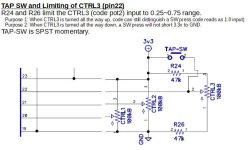Rpschultz13
Active member
I’m building a Hydra. Was wondering if it’s possible to grab a voltage from somewhere that would look like the delay frequency, like tap tempo.
Are you looking for a "circuit only" solution? Or are you able to modify the FV-1 patch(es) to set up a tap-tempo for the Hydra? The patches in the FV-1 will need to be edited to accommodate a tap-tempo input.I’m building a Hydra. Was wondering if it’s possible to grab a voltage from somewhere that would look like the delay frequency, like tap tempo.


